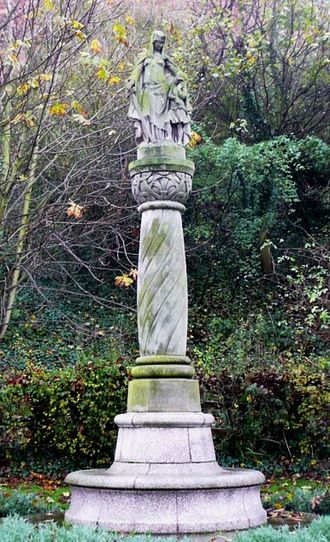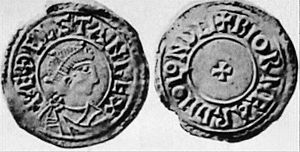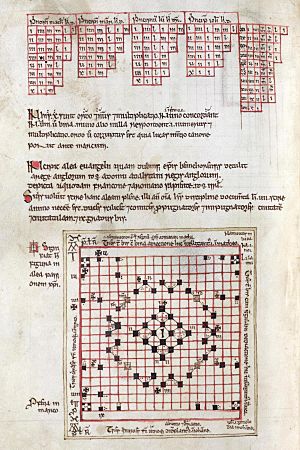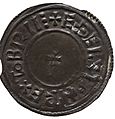Æthelstan facts for kids
Quick facts for kids Æthelstan |
|
|---|---|
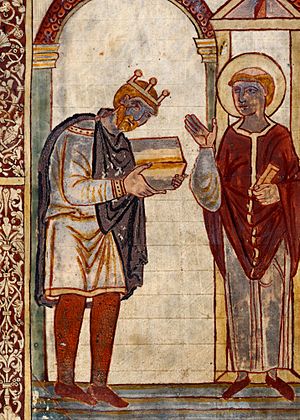
Æthelstan presenting a book to St Cuthbert, an illustration in a manuscript of Bede's Life of Saint Cuthbert, probably presented to the saint's shrine in Chester-le-Street by Æthelstan when he visited the shrine on his journey to Scotland in 934. He wore a crown of a similar design on his crowned bust coins. It is the oldest surviving portrait of an English king and the manuscript is the oldest surviving made for an English king.
|
|
| King of the Anglo-Saxons | |
| Reign | 924/5 – 927 |
| Coronation | 4 September 925 Kingston upon Thames |
| Predecessor | Edward the Elder |
| King of the English | |
| Reign | 927 – 27 October 939 |
| Predecessor | Title established |
| Successor | Edmund I |
| Born | c. 894 Wessex |
| Died | 27 October 939 (aged about 45) Gloucester, England |
| Burial | Malmesbury Abbey |
| House | Wessex |
| Father | Edward the Elder |
| Mother | Ecgwynn |
Æthelstan (born around 894 – died 27 October 939) was a powerful king in early England. He was the son of King Edward the Elder and his first wife, Ecgwynn. Æthelstan was King of the Anglo-Saxons from 924 to 927. Then, from 927 until his death in 939, he became the first true King of the English. Many historians today see him as the first King of England and one of the greatest Anglo-Saxon rulers. He never married or had children. His half-brother, Edmund I, became king after him.
When his father, King Edward, died in July 924, Æthelstan was accepted as king by the people of Mercia. There was some resistance in Wessex for a few months. He was finally crowned king in September 925. In 927, he conquered York, the last remaining Viking kingdom in England. This made him the first Anglo-Saxon ruler of the entire country.
In 934, Æthelstan invaded Scotland. He forced Constantine II to accept his rule. The Scots and Vikings were not happy with Æthelstan's power. In 937, they invaded England. Æthelstan defeated them in the famous Battle of Brunanburh. This victory made him very respected across Britain and Europe. After he died in 939, the Vikings took back control of York. It was not fully brought back under English rule until 954.
Æthelstan made the government stronger and more organised. He also created more laws than any other English king of his time. These laws aimed to stop robberies and keep peace. He was a very religious king. He collected holy items (relics) and helped build churches. His royal court was a centre for learning in England. It helped set the stage for a big religious reform later in the century. Æthelstan also played a major role in European politics. He arranged for several of his sisters to marry rulers from other countries.
Contents
Becoming King
Æthelstan was born around 894. He was the oldest son of King Edward the Elder. His mother was Ecgwynn. Not much is known about Ecgwynn. Some people questioned if Æthelstan was the rightful heir. However, many historians today believe she was Edward's lawful wife.
A historian named William of Malmesbury wrote that Alfred the Great, Æthelstan's grandfather, held a special ceremony for young Æthelstan. Alfred gave him a scarlet cloak, a jewelled belt, and a sword. Some historians think this meant Alfred saw Æthelstan as a possible future king.
Edward the Elder married two more times after Ecgwynn. His later marriages gave Æthelstan several half-brothers and sisters. These new marriages made Æthelstan's position less secure. His stepmothers naturally wanted their own sons to become king.
Æthelstan probably grew up and received military training in Mercia. He lived with his aunt and uncle, Æthelflæd and Æthelred. They were important rulers in Mercia. This experience helped him understand and connect with the Mercian people.
Taking the Throne
King Edward died in July 924. What happened next is a bit unclear. Æthelstan was in Mercia and was quickly accepted as king there. His half-brother, Ælfweard, might have been chosen as king in Wessex. But Ælfweard died just sixteen days after their father.
Even after Ælfweard's death, some people in Wessex were against Æthelstan. He was not crowned until 4 September 925. His coronation took place in Kingston upon Thames. This town was chosen because it was on the border between Wessex and Mercia. The ceremony was new and special. It was the first time an English king wore a crown instead of a helmet.
There were still some problems after the coronation. A nobleman named Alfred supposedly plotted against Æthelstan. He wanted to blind the king, which would make him unable to rule. This plot might have been linked to questions about Æthelstan's right to be king. Later, in 933, Æthelstan's younger half-brother, Edwin, died in a shipwreck. Some old stories suggest Æthelstan was involved, but most historians do not believe this. Edwin might have fled England after trying to rebel against the king.
Uniting England
King Edward the Elder had conquered many Viking areas in England. But when he died, a Viking king named Sihtric still ruled the Kingdom of York in the north. In 926, Æthelstan made a deal with Sihtric. He arranged for his only full sister to marry Sihtric. They agreed not to attack each other.
However, Sihtric died the next year. Æthelstan quickly took the chance to invade. He captured York easily and the Danish people there accepted his rule. This was a huge step! Southern English kings had never ruled the north before. This made Æthelstan the first Anglo-Saxon ruler of all England.
After this victory, Æthelstan met with other rulers at Eamont Bridge in 927. These included King Constantine II of Scotland, King Hywel Dda of Wales, and other British leaders. They all accepted Æthelstan as their "overlord." This meant they recognised him as the most powerful ruler in Britain. This led to seven years of peace in the north.
Æthelstan also had power over the Welsh kings. He inherited this from his father. He called the Welsh kings to Hereford. There, he set a high yearly payment (tribute) they had to give him. He also set the border between England and Wales at the River Wye. The Welsh kings attended Æthelstan's court. This showed they accepted his authority. This alliance brought peace between Wales and England.
Æthelstan also strengthened his control over Cornwall. He set the border at the River Tamar. He also created a new church area (diocese) there. This showed his strong rule over the whole island.
Æthelstan became the first king of all the Anglo-Saxon people. He was effectively the overlord of all Britain. He tried to make the people in Northumbria accept his rule. He gave many gifts to churches there. But the northern kingdoms still preferred to ally with the Norse (Vikings) from Dublin. His power in the north was not as strong as in the south.
War with Scotland and Vikings
In 934, Æthelstan invaded Scotland. The reasons are not fully clear. One idea is that King Constantine of Scotland had broken a treaty with Æthelstan. Æthelstan's army was very large. It included four Welsh kings and many bishops and earls. His forces attacked by land and sea. They went as far north as Dunnottar Castle. This was the furthest north any English army had gone in centuries.
No major battles are recorded during this campaign. By September, Æthelstan was back in England. Constantine witnessed a charter, accepting Æthelstan's overlordship again.
In 937, a new Viking king, Olaf Guthfrithson, joined forces with Constantine of Scotland. They also allied with the Strathclyde Britons. Together, they invaded England. This was a huge invasion. Æthelstan gathered his army from Wessex and Mercia. The Welsh kings did not join either side.
The two armies met at the Battle of Brunanburh. Æthelstan won a great victory. His young half-brother, Edmund, also fought bravely. Olaf escaped back to Dublin. Constantine lost a son in the battle. The English also suffered heavy losses.
This battle was remembered as "the great battle" for generations. The Anglo-Saxon Chronicle wrote a long, heroic poem about it. It praised Æthelstan as the ruler of an empire. The exact location of the battle is still unknown. Many historians think it was at Bromborough on the Wirral.
Historians agree the battle was very important. If Æthelstan had lost, his control over Britain might have fallen apart. It cemented his reputation as a powerful and victorious king.
How Æthelstan Ruled
Government and Law
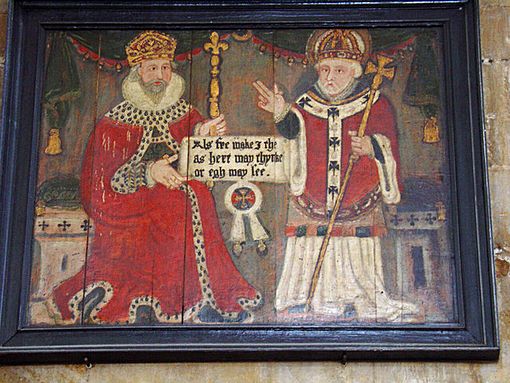
Æthelstan ruled his large kingdom through powerful officials called ealdormen. These officials managed large areas. He also had royal officials called reeves in charge of towns. Church leaders worked closely with these officials.
As the first king of all Anglo-Saxon peoples, Æthelstan needed a strong government. He made the government more centralised than ever before. This meant the king had more direct control. For example, important royal documents called charters were all written by one special scribe for several years. This showed the king's strong control.
The king's council, called the witan, was very important. Anglo-Saxon kings did not have one fixed capital city. They travelled around their kingdom. Æthelstan mostly stayed in Wessex. But he called important people from all over his kingdom to his councils. These meetings were much larger than before. Bishops, ealdormen, and even other independent rulers attended. This helped unite England and break down local differences. Some historians even see these councils as the beginning of the English Parliament.
More laws from Æthelstan's reign survive than from any other king of his time. His laws were based on those of his grandfather, Alfred the Great. Æthelstan was very worried about robberies. He saw them as a big threat to peace. His laws had harsh punishments for thieves, even the death penalty for those over twelve years old. Later, he raised the age for the death penalty to fifteen. He thought it was too cruel to kill so many young people.
His reign also saw the start of the "tithing" system. This was where groups of ten or more men were responsible for keeping the peace together. If one person committed a crime, the others in the group were responsible for bringing him to justice.
Coins and the Church
Æthelstan wanted a single type of money across his kingdom. His coins showed his new power. After he conquered York, he issued new coins with the words "Rex Totius Britanniae" (King of the whole of Britain). Later, he issued coins showing him wearing a crown for the first time.
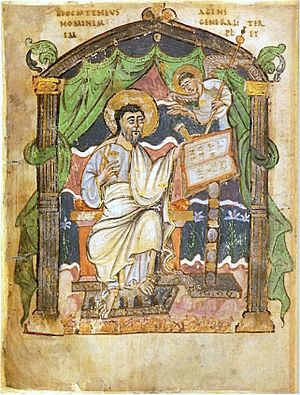
The Church and the government were very close in Anglo-Saxon times. Æthelstan made these ties even stronger. He appointed many of his own trusted people to important church positions. Two important figures in a later church reform movement, Dunstan and Æthelwold, served at Æthelstan's court. They learned much from the king's wise men.
Æthelstan was famous for collecting holy items (relics). He also gave many valuable books and relics to churches. He was especially devoted to St Cuthbert in Chester-le-Street. He gave them a special book about Cuthbert, which included the oldest surviving portrait of an English king.
He also built strong ties with churches in Europe. He sent a bishop to tour German monasteries. The bishop gave gifts from Æthelstan and received promises of prayers for the king. This helped spread new ideas about church reform to England.
Learning and Culture
Æthelstan continued his grandfather Alfred's work to bring back learning. He was known for his religious devotion and for supporting education. His interest in books and relics attracted many scholars to his court. These included scholars from Brittany and Ireland. His court played a key role in the start of the English monastic reform movement.
Not many stories or histories survive from Æthelstan's time. But there was a lot of poetry written, often praising the king. Some historians even think the famous poem Beowulf might have been written in Æthelstan's time.
The writing style used in his charters was very complex and fancy. It showed a high level of learning. This style influenced later writers and showed that the kingdom was strong and successful.
King of Britain and Europe
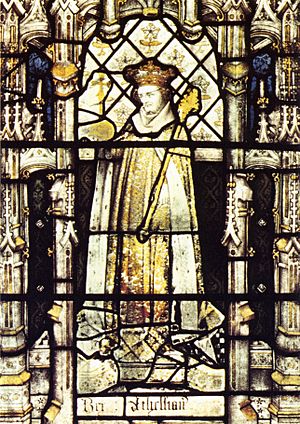
Æthelstan used grand titles for himself. On his coins and charters, he was called "King of the whole of Britain." In one book, he was even called "basileus et curagulus," which were titles used by Byzantine emperors. Some historians think these titles were a bit exaggerated. But others say that Æthelstan truly had a wide influence across Britain.
Æthelstan had very close ties with other European royal families. He did not want his sisters to marry his own subjects. So, he arranged for several of his half-sisters to marry European nobles. This was very unusual for the time. These marriages helped create strong alliances. They also showed how powerful and respected the English royal family had become.
His most important alliance was with the new ruling family in Germany. In 929 or 930, the German king sent ambassadors to ask for one of Æthelstan's sisters to marry his son, Otto. Otto later became the Holy Roman Emperor. Æthelstan sent two of his half-sisters. Otto chose Eadgyth. This marriage made England and Germany very close.
Æthelstan was also known for helping young, dispossessed royals. He acted as a foster-father to the sons of other kings. In 936, he sent an English fleet to help his foster-son, Alan II, regain his lands in Brittany from the Vikings. He also helped his half-sister Eadgifu's son, Louis, become king of West Francia. He even helped Hakon, the son of the King of Norway, reclaim his throne. Hakon was known in Norway as "Æthelstan the Good."
Æthelstan's court was perhaps the most diverse in Anglo-Saxon England. Foreign visitors and scholars were common. He played a very important role in European politics. Many foreign writers praised him. One called him "the king from overseas." Another called him "the pillar of the dignity of the western world." Some historians see him as the most powerful ruler in Europe at the time, like a new Charlemagne.
Death and Legacy

Æthelstan died in Gloucester on 27 October 939. He chose to be buried at Malmesbury Abbey. This was different from his grandfather and father, who were buried in Winchester. He chose Malmesbury because he loved the abbey and its saint, Aldhelm. His bones were lost later during the Reformation. But an empty tomb from the 1400s still honours him there.
After Æthelstan died, the Vikings in York immediately chose their own king again. The English control of the north fell apart. His half-brothers, Edmund and Eadred, spent their reigns trying to win back control. York was finally brought back under English rule in 954.
Historians today see Æthelstan as one of the greatest kings of the West Saxon family. He is often called the first King of England. His strong campaigns made it possible for his successors to finally conquer Viking York. He created the most organised government England had seen. This laid the groundwork for England to become one of the wealthiest and most advanced countries in Europe. He also continued his grandfather's work to revive the Church and learning.
Æthelstan was highly respected when he died. He was seen as a successful military leader, a good king, and a religious man who supported learning. Later, his fame faded compared to Alfred the Great. But many modern historians now agree that Æthelstan was a truly important figure. He was the "roof-tree of the honour of the western world."
Images for kids
See also
 In Spanish: Athelstan para niños
In Spanish: Athelstan para niños


